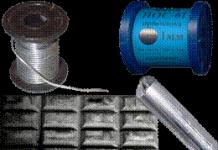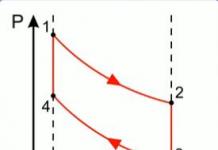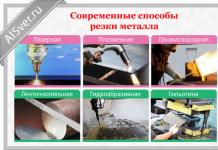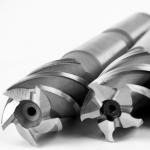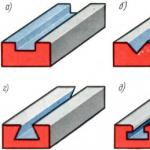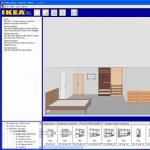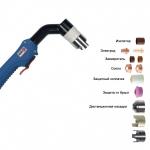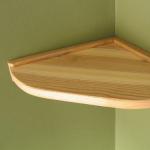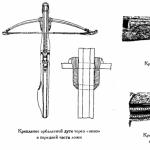An angle grinder is considered to be extremely traumatic equipment, so it is important to know in advance how to properly cut metal with a grinder in order to avoid injury and cope well with the task. It is necessary to monitor compliance with safety measures during work and use personal protective equipment: use a respirator, wear protective gloves or mittens, goggles, etc.
Cutting equipment must be used strictly for its intended purpose, all work is carried out using special circles for metal. It is strictly not recommended to remove the protective cover. How to work with a grinder, see the video:
How to cut a metal corner with a grinder
It is impossible to start cutting metal with a grinder without obtaining the appropriate knowledge and some skills. The most important danger is the possibility of jamming of the cutting wheel in the cutting zone and its subsequent destruction. When carrying out work, the grinder must be firmly held with both hands. You need to cut strictly from yourself. The depth of the cut is determined by the diameter of the disc.
Cutting a metal corner has some nuances:
- A large corner (more than 60 mm) is more convenient to cut together with a partner. In the conditions of the workshop, the workpiece is clamped in a bench vise or fixed with clamps on a fixed base. The corner is laid on the surface of the supporting structure (table, box, etc.) so that the cut edge hangs, and its other part lies completely on the surface of the support. At the same time, the assistant should press the workpiece and slightly pull it away from him to prevent the disc from biting. Cutting starts from the edge, moving towards the edge.
- Cutting a corner with smaller dimensions (up to 60 mm) is allowed to be carried out without the help of outsiders. The material to be cut is laid out with support on both shelves (edge up). The detachable part must be in weight and not touch the ground or floor. The remaining part is pressed down with the left foot (in the absence of the possibility of rigid fixation), in order to hold the grinder with both hands. Cutting should start from the edge, gradually going down and deepening into the corner areas.
If the correct metal cutting technology is observed, the detachable fragment will fall down under its own weight, thereby increasing the width of the cut zone. The chance of disc jamming is minimized.
How to cut a pipe with a grinder
The technology of work is as follows:
- The pipe is fixed in a vise or fixed in another way. In this case, the cut off part should hang over. It is not allowed to place the workpiece between two supports and cut in the middle, because the cutting blade will jam (due to pipe sagging).
- Using a strip of paper and masking tape, markings are applied. The ends of the tape should converge as accurately as possible. Home craftsmen recommend lowering the pipe into the liquid at the required angle, and then marking the cut line along the border of dry and wet.
- The cut should be made from the top of the pipe, gradually lowering the angle grinder below. The cutting disc must run along the very edge of the glued strip.
A large diameter pipe is cut a little differently, since the working part of the circle does not allow it to be done in one go. The wall is cut sector by sector, and the pipe is turned to the desired side.
How to cut aluminum with a grinder
For cutting aluminum with a grinder, a different type of disc is used, because it is a soft metal and the cutting tool gets stuck in it. There are special cutting discs for aluminum and copper.
You should not try to make a cut in one pass, because cold hardening is formed on the teeth of the cutting tool and it is clamped in the material. The cut is performed carefully, without cutting through the metal to the end. It is necessary to pass several times in one place and avoid distortions. The process is quite slow, and the quality of the cut will be low. When cutting blanks of large thickness, experts recommend dripping kerosene into the cutting zone. With aluminum, it is better to work with a manual router, which allows you to perform figured cutting and make holes. And it's possible like this:
Stainless steel cutting methods
Stainless steel refers to alloy steels, which are quite difficult to process. This metal can be cut in 2 ways:
- thermal (metal melts under the influence of high temperatures);
- mechanical (cutting is carried out using a cutting tool by removing a layer of metal).
Thermal methods include:
- Cutting with oxygen (gas-arc cutting). Metal melts under the influence of an electric arc. Oxygen supplied to the cutting zone contributes to the combustion of the metal and the removal of slag from the working zone.
- EDM cutting. The cutting process consists in the destruction of the surface of the workpiece under the influence of an electric discharge.
- Waterjet cutting. The metal is separated under the action of a thin jet of abrasive mixture supplied under ultra-high pressure.
- Laser cutting. Processing is carried out with a thin laser beam.
- Plasma cutting. The plasma jet acts as a cutting tool.

Machining of stainless steel is performed with the following tools:
- Metal scissors. They cope with sheets having a thickness of not more than 0.5-1 mm.
- A circular saw. Cutting is carried out using a cut abrasive wheel. This method can cut parts of large thickness.
- Angle grinder. When cutting metal with a grinder, special thin stainless steel discs with a diameter of 125 mm are used. Non-specialized tooling can subsequently cause corrosion phenomena in the metal.
According to the cutting rules, the part must be securely fixed or rested against something, otherwise the workpiece may be pulled to the side and the cut will be broken. You will need to additionally process the cut edge if you cut without following the technology.
Cutting cast iron grinder
Cast iron is a rather brittle metal, but very durable, so it is recommended to use diamond-coated discs for cutting it. You can cut cast iron with simple metal discs, but they are much less durable. You can cut this material with a grinder only in a straight line. Any attempt to make a figured cut can lead to jamming of the cutting wheel. As a result, under heavy loads, the abrasive element is destroyed and its parts flying out at high speed can severely injure people nearby. But it is better to cut cast iron with a saw, as in the video:
You can use the grinder for cutting cast iron only when using a respirator (a lot of dust is formed), protective plastic goggles and gloves. Bakelite bonded cutting equipment is more suitable for this job. Ceramic bonded discs have a much lower margin of safety.
A grinder for working with metal is the best solution. This versatile tool allows you to use it not only for cutting, but also for polishing, deburring, grinding metal and many other operations.
metalwork cutting
TO Category:
metal cutting
metalwork cutting
Cutting is the process of dividing a workpiece into pieces of a given size and shape. Cutting is used to obtain workpieces of a given size and shape from rolled bars and sheets, as well as slots and holes in the workpieces. Modern cutting methods provide high-performance processing of workpieces of almost any size and from materials with any physical and mechanical properties.
There are the following technological methods of cutting.
1. Sawing with hacksaws, band and circular saws. It is used for cutting high-quality rolled products.
2. Cutting with scissors. It is used for cutting sheet metal.
3. Cutting on metal-cutting machines (turning, milling, etc.).
4. Anode-mechanical, electric-spark and light-beam (laser) cutting. These methods are used in cases where other methods do not provide sufficient performance and the required quality. For example, they are used for cutting high-strength materials along complex and precise contours, etc.
5. Oxy-acetylene cutting. It is used for cutting workpieces of considerable thickness from carbon steel. It does not provide high accuracy, leads to a change in the structure and chemical composition of the material at the cutting site. However, it is widely used in single production due to its simplicity, high performance and versatility.

Rice. 1. Sawing (a) and cutting blanks on scissors (b): 1 - blank, 2 - knives; y - rake angle, a - back angle, P - taper angle, 8 - cutting angle
Cutting can be done both manually and mechanically.
The physical essence of cutting is based on various methods of destruction of the material of the workpiece at the place of the cut.
When sawing and cutting on metal-cutting machines, the force F applied to the cutting wedge is directed at an acute angle to the surface being machined. Therefore, the cutting wedge cuts the material and turns it into chips. When cutting with scissors, the force F applied to the cutting wedge is perpendicular to the surface being machined. Therefore, the tool cuts the material without forming chips.
Electric spark cutting is based on electrical erosion (destruction) of the workpiece material. Capacitor C, included in the charging circuit, is charged through resistor R from a DC source with a voltage of 100-200 V. When the voltage on the electrodes (tool) and (workpiece) reaches the breakdown voltage, a spark discharge occurs between their nearest microprotrusions with a duration of 20-200 μs. The discharge temperature reaches 10,000-12,000 °C. At the place of discharge on the workpiece, an elementary volume of the material instantly melts and evaporates, and a hole is formed. The removed material in the form of granules remains in the dielectric medium (oil) in which the processing takes place. Discharges that follow continuously one after another destroy the entire workpiece material located at a distance of 0.01-0.05 mm from the tool. To continue the processing process, the electrodes must be brought together, which is done automatically.

Rice. 1.6. Electric spark cutting of workpieces: 1 - wire-tool, 2 - workpiece
During oxy-acetylene cutting, the workpiece metal at the cutting site is first heated with an oxy-acetylene flame to its ignition temperature in oxygen (for steel 1000-1200 ° C). Then a stream of oxygen is directed to this place and the metal begins to burn. This releases so much heat that it is enough to maintain a continuous cutting process.
Anode-mechanical cutting is based on the combined destruction of the workpiece material - electrical, chemical and mechanical. A direct current flowing at the cut between the workpiece and the tool causes electrical erosion of the surface of the workpiece. The resulting molten material particles are carried out of the processing zone by a rotating tool - a disk. At the same time, the electrolyte supplied to the treatment zone, under the action of an electric current, forms oxide films on the surface of the workpiece, which are removed by the same rotating tool.
Cutting tools. When sawing, hacksaw blades (for manual and mechanical hacksaws), band and circular saws are used as cutting tools. Hacksaw blades and band saws are a thin strip of high-speed or alloyed (Kh6VF, V2F) steel with fine teeth in the form of wedges on one or two sides. Band saws are made by bending a band into a ring and soldering its ends with high-temperature solder. In a circular saw, the teeth are located on the periphery of the disc. The cutting teeth are hardened to a hardness of 61 - 64 HRQ. To prevent the tool from jamming in a narrow cut, its teeth are bred.
When choosing a tool for sawing, first of all, the length of the cut and the hardness of the material being processed should be considered.
With long cuts, it is necessary to choose blades with a large tooth pitch, and when processing thin-walled workpieces - with a fine one. At least three teeth must be involved in cutting at the same time.
The higher the hardness of the material to be machined, the larger the taper angle should be. The chips formed in this case are comma-shaped and fit tightly in a small space. When machining soft materials, tools with large chip space should be used. A positive rake angle improves productivity because the tooth cuts rather than scrapes the workpiece material.
For processing high-strength materials, hacksaw blades with synthetic diamonds on the working surface are used.
For cutting sheet material, cutting tools in the form of knives are used, which are most often removable. Knives come with straight, curved and round (roller and disc) cutting edges.
In anodic mechanical cutting, thin discs of mild steel are used as a tool. On an electric spark machine, a continuously moving wire is used as a cutting tool.
Equipment and devices for cutting. In the conditions of the tool shop, small workpieces are cut with a hand saw. The hacksaw blade is fixed in the frame so that the teeth are directed away from the handle.
Manual lever shears are designed for cutting sheet material. Tool shops use small portable scissors. They can cut sheet steel up to 4 mm thick, aluminum and brass - up to 6 mm.
Manual scissors are designed for cutting sheet material, manufacturing blanks with a curved contour, cutting holes in blanks with a complex contour. For a straight cut, scissors with straight wide knives are used. If the upper cutting edge is located to the right of the lower one, then the scissors are called right, and if on the left - left. To obtain external curvilinear cuts, hand-held scissors with curved wide knives are used. Cutting out internal curvilinear contours is carried out with scissors with narrow curved knives.
Mechanical cutting of sheet material is carried out with manual electric shears, vibrating shears, as well as on roller, multi-disc and sheet shears.
The sequence and methods of work when cutting. Cutting is preceded by marking. Then choose the cutting method, equipment and tool.
Of great importance for high-quality processing is the correct execution of cutting techniques. The location of the workpiece and tool during manual cutting should be such that the marking risk is constantly available for observation. With a large cut length, the pressure on the hacksaw is increased, with a small one, it is reduced. Since the teeth of the hacksaw break especially easily at the beginning and end of the cut, at these moments the pressure on it should be minimal.
When cutting, hand shears should be opened to 2/3 of the length of the cutting edges. In this case, they easily capture the workpiece and cut well. The cutting plane must always be perpendicular to the cutting surface of the workpiece. Misalignment leads to binding, edge crinkling and burrs.
Proper tool alignment is essential. So, with a weak tension of the hacksaw blade in a hand saw, the cut is oblique. A large gap between the knives leads to the formation of burrs. The appearance of burrs with correctly adjusted knives is a signal of their blunting.
When cutting with a hand saw, you should stand freely and straight, half-turned to the vise.
There is an opinion that the very concept of "Bulgarian" came into our everyday life because this instrument was first brought from Bulgaria. This is partly true. But they developed and began to produce it in Germany. It first came to us from Bulgaria, where it began to be produced in the seventies. Angle grinder is the correct name for the tool.
When working with an angle grinder, it is imperative to observe safety precautions, namely: wear glasses, gloves, a helmet and a protective apron.
It is impossible today to imagine the work of builders, repairmen, mechanics, locksmiths without a grinder. With its help, you can cut a variety of materials, including metal: rebar, rod, water pipes, corner, profile.
The resulting sections can be ground, polished, sharpened. A large selection of interchangeable nozzles makes this tool indispensable and versatile.
At the same time, it is the most traumatic tool.
To cut metal with a grinder you will need:
- mask;
- glasses;
- disks;
- Bulgarian;
- metal.
How to choose the right grinder

The grinder should lie comfortably in the hand.
The right choice and quality of the grinder itself determines the quality of work and the safety of the worker.
When choosing a machine, you should focus on its main parameters: power and diameter of the cutting abrasive wheel. Equally important are its weight, since it is often necessary to work “on weight”, and dimensions so that you can work in inconvenient and hard-to-reach places.
Most buyers, at the sight of a powerful angle grinder, are somewhat afraid that it is more difficult to deal with it than with a low-power one. This is an erroneous opinion. In grinders of low power, jamming of disks occurs more often, i.e. they physically cannot “pull out” the disk under heavy loads. The situation, how the disk and the machine itself will behave after the load is reduced, is unpredictable. Most likely, the grinder will be torn from the hands. The consequence of this will be a fracture of the disk, damage to the machine and injury to the cutter. Therefore, it is better for novice craftsmen to purchase a grinder for a 125 mm disk with a power of 800-1000 W and a spindle speed of 10,000 rpm. This power is enough to cut iron.
For cutting metal, there are machines for a 115 mm disk powered by batteries, but, as practice shows, with their high cost in solving everyday problems, they do not justify themselves.

The handles of the grinder should be rubber or made of a material that will dampen vibrations from the machine.
But no technical characteristics reflect the convenience and safety of work. The grinder should lie comfortably and securely in the hand so that when working with metal, focus on it, and not on how to hold the tool in your hands. It is desirable that the handles be rubber or made of material that dampens vibrations, with recesses for the fingers.
Low-power grinders, as a rule, do not have an additional handle.
If any inconvenience was found during the selection, you should look for an angle grinder of another model.
How to choose the right wheels

There are signs on the circle that will help you choose the right circle.
When choosing discs, you need to know what they will be used for, pay attention to their diameter and thickness. These are the main parameters of the disks.
The smallest diameter is 125 mm, and the maximum, of the publicly available, is 250 millimeters. In professional angle grinders, discs can be larger in diameter.
The thickness of the part to be cut and the maximum depth of the cut depend on the diameter of the disc.
If you plan to cut only metal, you need to purchase a cutting disc. It has the smallest thickness from 1 to 1.2 mm, for industrial angle grinders - up to 2.5 mm. This will ease the physical burden on the grinder and on the worker. The cut is neat.
If figured carving on thin metal is planned, then it is made with a disk of the smallest diameter or an old, almost used disk.
Many people think that you need to use a diamond blade to cut metal. This is a completely wrong opinion. The diamond disk in the metal will simply get bogged down and will be unsuitable for further work.
Experts say that even beginners do not have any special difficulties when cutting metal with a grinder.
Basic rules for safe work when cutting metal with an angle grinder

The layout of the most dangerous sectors when working with a grinder, taking into account the rebound and destruction of the disk.
The most necessary condition for cutting is the strict observance of the rules of safe work.
Manufacturers of angle grinders are constantly trying to minimize the risks of injury and injury by inventing and improving various protection systems. But no one will take care of the worker as he does.
The main dangers that arise when cutting metal are the flight of fragments of a broken disk, the flow of sparks and the smallest abrasive particles, the inability to hold a tool in your hands.
If the disc breaks or jams, the angle grinder can break out of your hands at the most inopportune moment and with great force, so even before starting work, you should foresee the direction of its possible movement.
Safety rules cannot be neglected even when performing small jobs.
Before starting work, you should:
- Protect face, eyes, hands, if possible and all parts of the body.
- Remove all combustible materials and objects that are in the direction of the sparks.
- Secure the part being processed by the grinder, if possible, in a vice. Do not hold the workpiece with your free hand or press it with your feet.
- If a new disk is installed, you need to “scroll” it with a grinder at maximum speed, placing it away: the disk may turn out to be defective and shatter into pieces.
- Install, adjust and fix the protective cover.

It is best to protect your face with a special shield when working with a grinder.
During work, you should:
- When replacing discs during the rest, it is necessary to disconnect the grinder from the network.
- To protect the eyes and face, use goggles or a protective shield - professionals use both during prolonged work.
- Hold the grinder firmly during the entire work.
- To replace the disk, you need to wait until it stops completely.
- Work in protective gloves. It is undesirable to use cotton mittens, they do not provide sufficient protection, they can ignite, and the threads will be wound around the grinder spindle or disk.
- During work, you need to position yourself so that the face, and if possible, all parts of the body are not in the plane of rotation of the disk.
Upon completion of work, you should:
- wait until the disk rotation stops completely and only after that put the tool on the floor with the disk up so as not to damage it;
- disconnect the grinder from the network;
- make sure there is no smoke or other signs of fire.
A typical mistake that is made when cutting metal: if the diameter of the new circle is larger than the size of the protective cover, it is removed. The casing is protection in case the disc breaks and shatters into pieces in the process.
Instead of a disk, many put cutters, saws or other improvised materials. Doing this is strictly prohibited.
How to cut metal with a grinder. Practical advice and recommendations

If long pipes lie on supports, you need to cut their hanging edge. If you cut them in the middle, then due to its own weight, the metal will bend and clamp the disk.
If there are no skills in handling a grinder, then before starting work, you should learn how to cut on unnecessary parts.
The cutting wheel only accepts radial forces. Attempting to change the cutting plane while the blade is inside a metal part will break the blade.
The disc heel (near lower part of the circle) cuts metal more efficiently.
In order for the grinder and discs to serve for a long time, every 5-7 minutes of work you need to take a break for 20-30 minutes. This rule is especially important for low-power angle grinders who are afraid of overheating.
To increase the service life of discs, especially expensive ones, and to cool the metal, the cut should be watered. It is advisable to work together.
Aluminum is a very tough metal. When cutting parts of large thickness, kerosene must be dripped into the seam, observing fire safety rules.
For molding, sawing tin, curly carving, you should use worked-out disks - “stubs”, so you should not immediately throw them away.
It is correct to cut the corner not in one go, but separately both shelves.
If long enough pipes, corners, fittings lie on supports, it is correct to cut the hanging edge. If you cut between the supports, the part will bend due to its own weight and jam the disc.
Parts of large thickness are cut only in a straight line. If you need to cut out a figured part, straight cuts are first made, then the remaining unnecessary parts are removed.
You should not put pressure on the grinder. This will lead to jamming or breakage of the disc and overheating of the grinder. If the cutting process is slow, the blade should be replaced.
The resulting cut should not be processed with the side of the disk. For this, a different type of disk is used.
Molten particles of metal and abrasive, falling on plastic products, glass and car headlights, stick to them, and then it is almost impossible to remove them. Therefore, before starting work, they must be removed or protected.
Is it possible to use a grinder for cutting metal tiles and corrugated board?
At a time when they just started using metal tiles and corrugated board, the instructions said that it was strictly forbidden to use a grinder to cut these roofing materials. This is explained by the fact that on both sides they are protected by zinc and polymer coatings and painted.
The abrasive disc heats and melts the material. The cuts are torn. Flying sparks also break the paint. All this causes corrosion of the material and a decrease in service life.
Nevertheless, recently builders have begun to use a grinder for this work. This greatly facilitates the work, it can be carried out directly on the roof. After cutting, the edges must be treated with anti-corrosion agents, primed and painted.
Brief conclusions
Correctly cutting metal with a grinder is not difficult. Everything can be learned. The main thing is to follow the safety rules and follow the recommendations.
cutting off(cutting) - the process of completely separating one part of the material from the whole (bar, bar, corner, etc.) using a cutting tool on metal-cutting machines.
Cutting(cutting) - the process of completely dividing the whole (bar, bar, angle, etc.) into equal or unequal parts using a cutting tool on metal-cutting machines.
cutting through(cutting) - the process of forming one or more dimensional narrow grooves (slots, slots) in the workpiece using a cutting tool on metal-cutting machines.
Cutting and slotting cutters (slotted). Parting off workpieces on milling machines is carried out by cutting cutters, cutting grooves and slots - slotted (slotted) cutters. Cut-off and slotted cutters have cutting edges located along the periphery and do not have cutting edges at the ends. According to GOST 2679-61, slotting and cutting cutters are made of three types: type I - with a small tooth, type II - with an average (normal) tooth, type III - with a large tooth. Slotting cutters of types I and II with a diameter of 32 to 80 mm are mainly used for cutting grooves and splines and are manufactured in two accuracy classes: AA and A (precise execution). Cut-off cutters of all types and diameters with a width of 1 mm and above are manufactured according to accuracy class B (normal version). Cutting cutters are intended for cutting the whole into parts (for example, cutting a workpiece into several equal or unequal parts) and cutting off from a whole part, for example, cutting one workpiece from a bar. Cut-off cutters with fine and medium teeth are intended for processing steel and cast iron, cutters with large teeth are used for processing aluminum, magnesium and other light alloys.
Cut-off cutters with a fine tooth are produced with a diameter D = 32-250 mm, a width B = 0.2-5 mm, with a number of teeth z = 56-140; cutters with an average tooth have, respectively, D = 50-250 mm, B = 0.5-5 mm, z = 32-80; cutters with a large tooth - D \u003d 50-250 mm, B \u003d 1-5 mm and z \u003d 14-40. Large workpieces are cut with saw blades. These saws have a diameter D = 275-2000 mm, a width B = 5-14.5 mm, a bore diameter d = 32-240 mm and a number of segments 14-44. The segments are made of high-speed steel and fastened on a disk made of steel 50G or 65G with three or four rivets.
Slotting cutters with fine and medium teeth are designed for cutting shallow slots in the heads of screws or castle nuts, cutting shallow grooves. Slotting cutters with a large tooth - for cutting deep slots and grooves.
To reduce friction during processing, cutting and slotting cutters have an undercut angle φ 1 (the width of the cutter decreases from the periphery to the center). For slotted cutters φ 1 = 5-30", and for cutting cutters φ 1 = 15"-1°. In order to improve the working conditions of the cutters and increase their durability on the teeth, transitional cutting edges are made.
Transitional cutting edges can have three varieties. For cutters produced in a centralized manner, the transitional cutting edges are made in form 1 and serve to separate the chips in width.
Cutting and slotting cutters D = 32-250 mm are mounted on mandrels with a diameter of d = 8, 10, 13, 16, 22, 27 and 32 mm. The optimal diameter of cut-off cutters is selected based on the same conditions as for disc cutters.
Solid carbide grooving cutters designed for cutting grooves in workpieces made of stainless, chromium, acid-resistant, heat-resistant and other hard-to-machine materials. They are manufactured according to industry standards with a diameter of 7 to 60 mm and a thickness of 0.5 to 3.5 mm from hard alloys of various grades. The use of hard-alloy cutters made of high-speed steel can significantly increase labor productivity by increasing the cutting speed and increasing tool life by 10-20 times. The quality of the machined surface is increased by two roughness classes.
Cutting workpieces into pieces. It is required to cut a steel angle 315 mm long into five equal parts 60 ± 10 mm in size.
Choice of cutter type and size. The cutter cutter diameter should be chosen as small as possible, since the smaller the cutter diameter, the higher its rigidity and vibration resistance. Therefore, when parting with cutters of small diameters, it is possible to give large feeds per tooth and obtain a better quality of the machined surface than when working with large diameter cutters. The durability of large diameter cutters will be less, and their cost will be higher. The optimal cutter diameter, as for disk cutters, can be determined by the formula D = 2r + d1 + (12÷16). In our case, t = 50 mm at d = 32 mm, d1 = 48 mm. Therefore, D \u003d 2 50 + 48 + 12 \u003d 160 mm. Take a cutting cutter made of high-speed steel 6RM5 D = 160 mm, B = 3 mm, d = 32 mm, z = 56 (type II - middle tooth).
When fixing the workpiece, special attention should be paid to the rigidity of the fastening of the workpiece and cutter. The workpiece is installed and fixed in a machine vice, as shown in Fig. 92, with an emphasis on the shelf for greater rigidity of fastening. The table with the fixed workpiece must be brought as close as possible to the frame. The cutting cutter must not touch the vise. The cutter is mounted on the mandrel as close as possible to the machine spindle, and the earring is closer to the cutter to ensure greater rigidity. To prevent the cutter from pulling the workpiece out of the vise, but pressing it against the vise, climb milling is used (by feed). However, with this method, there should be no play in the connection of the screw - nut of the longitudinal feed of the table.
Rice. 92. Fixing the workpiece in a vise
Setting for milling mode. The feed per tooth of cutting and slotting cutters made of R6M5 high-speed steel when processing steel is chosen in the range of 0.01-0.03 mm / tooth. Cutting speed within 30-60 m/min. Parting off and slotting - with coolant cooling.
It is preferable to cut off thin sheet material and cut it into strips with climb milling, since the cutting force in this case will press the workpiece against the table. However, as mentioned earlier, feed milling can only be performed if there is no longitudinal feed mechanism for the table. If the workpiece is mounted directly on the machine table, without pads, then the cutter on the mandrel should be placed against the T-slot in the machine table.
Milling of splines in the heads of screws or castle nuts is usually done in a fixture. On fig. 93 shows a diagram of a device for continuous milling of slots in the heads of screws installed in two rows. Here, the auxiliary time for loading workpieces and unloading the machined parts overlaps with the time for direct slot milling. The workpieces are placed manually on a continuously rotating disk.

Rice. 93. Scheme of a fixture for continuous milling of splines in screw heads
Fixing of workpieces in the fixture can be carried out automatically in the clamping prisms before approaching the slotted cutter. After milling the splines, the prisms expand, the machined parts fall out and fall into the box through the chute. If the automatic loading of blanks through the hopper device is carried out, then the processing cycle will be fully automated.
The process of milling slots in the device with circular feed is fundamentally no different from the case of conventional milling with longitudinal feed when the workpieces are placed on the machine table.
Metal is the material that the angle grinder (angle grinder) was originally designed to work with. Now, with its help, reinforcing bars, various metal sheets, pipes of various diameters, brick, concrete, stone, tile and other building materials are cut. Due to the presence of a variety of nozzles, the grinder also allows you to polish and grind the surfaces of products. Cutting metal with a grinder is one of the main, most frequent works. To reduce the likelihood of injury, it must be performed correctly, with strict observance of the requirements of general and personal safety.
Bulgarian belongs to the category relatively hazardous power tools. You can get injured from a scattered disc or a tool that has fallen out of your hands. In both cases, the danger is associated with the high speed of rotation of the device's electric motor.
To improve the efficiency of the grinder, expand its functionality, in practice use such accessories:
- tripods;
- clamps.

Their use allows to improve the quality of sawing metal blanks, to increase the accuracy of the process. Also, working conditions are improving from a safety standpoint, and its productivity is increasing.
The use of additional devices allows you to use the tool as a machine tool designed to perform different types of work.
In order to secure the cutting process as much as possible, you should work on metal with an angle grinder in compliance with a number of rules. They are conditionally divided into preparatory and main (working) activities.
Before starting cutting, it is necessary to carry out a number of manipulations.

If possible, the sawn material should be securely fixed in advance, for example, in a vice, in order to remove possible accidental movements. Do not hold workpieces in your hands or between your knees.

Proper tool operation
When you start sawing any part with an angle grinder, you should follow these rules.
- When cutting metal, hold the grinder firmly with both hands.
- Wheels can only be changed after they have completely stopped rotating and cooled down to an acceptable temperature by disconnecting the power tool from the mains.
- Do not put a working tool on the ground or a table (do not let go of it).
- Required intermittently for about 5 minutes stop for rest and keep the disk cool.
- It is necessary to constantly monitor the condition of the cutting wheel, preventing it from being pinched by the edges of the workpiece being cut.
- Do not leave a plugged-in tool unattended.
- Use only discs of the correct size as specified in the instruction manual for the device you are using.
- Better work done on a flat surface to keep the body in a stable position.
- Make sure that the power cord is away from a rotating circle, sharp edges, objects heated to more than 100 degrees.
- Movements not directly related to cutting should only be carried out with the power tool turned off.
- It is necessary to be located on the side or behind the tool, doing the work with your own hands so that the parts of the body are not in the plane of the cut.
When the cutting of the metal with the grinder is completed, you should wait until the disc stops completely, disconnect the power cord of the tool from the mains. After that, it is recommended to make sure that there are no signs of fire. When cutting right-handed materials, it is correct to hold the handle of the device in the area of the on / off button with your right hand. At the same time, the left hand is located on the handle screwed into the body of the power tool from above.
It is unacceptable to perform work using a grinder in a very tired state, or while under the influence of alcohol, psychotropic or narcotic drugs.
As for the question of which direction - towards itself or away from itself - the disk of the included angle grinder should rotate, there is no unequivocal answer here. The operating instructions indicate that the first option is correct. This is due to the fact that the resulting sparks fly off in the opposite direction from the operator, without causing harm. Also, fragments of the circle will fly in that direction if it shatters into pieces.
But in the case when a jamming of the disk rotating “on itself” occurs, the tool will fly off into the working one. For this reason, many experts prefer to cut metal so that the circle rotates “away from itself”. The power tool torn from the hands will fly in the opposite direction. This reduces the likelihood of injury, and clothing, shoes and gloves will protect the user from flying sparks.

Cutting sheet metal grinder
To cut metal of different types and thicknesses, use appropriate cut-off wheels of different thicknesses and diameters. The algorithm for cutting sheets is as follows.
- For cutting with a grinder, sheet metal is pre-laid on a flat surface.
- Mark with chalk (marker) the exact dimensions of the cut fragments on the surface of the sheet.
- Sawing is carried out along the marked lines, without changing the angle of the initial inclination of the disk to the working surface, so that it does not jam and break the power tool.
If there are no skills in sawing sheet metal with a grinder, it is recommended that you first practice on soft material This will give you a feel for how the instrument works.

It must be taken into account that the lower near segment of the disk cuts the metal more efficiently.
When cutting a sheet of metal, to obtain a quality result, you should take into account such recommendations.
- Cutting space required for better cooling pour water, which will also increase the life of the circle.
- It is worth starting cutting metal only when the disk is rotating: you cannot turn on the tool if the stationary circle is in contact with the surface of the workpiece.
- To cut tin (thin sheet metal) or cut out various geometric shapes, it is more convenient to use small, worked out circles("stubs").
- You should not press the grinder with significant effort: cutting should occur almost exclusively under the own weight of the angle grinder.
- If the cutting wheel stops in the slot (when the power tool is turned off), then work can only be resumed after it has been removed.
If sawing the sheet is slow, you should change the working head. Excessive load on the angle grinder when cutting metal will lead to its overheating or jamming of the rotating circle.
Cutting a round hole in metal with an angle grinder
In practice, it is often necessary to cut a circle in metal, and only an angle grinder is available from the tools. But it is quite enough for this purpose. The algorithm of actions is the following.
- A circle is drawn with a compass on the metal surface or according to a pre-made paper (cardboard) template with chalk or a marker.
- Holding the grinder at an angle to the surface of the sheet, a preliminary marking cut of the metal is performed along the marked contour, making short movements with the disk (sawed in small segments).
- Then, moving the nozzle in the same way, deepen the slot until it is completely cut out.

Need to cut along the outer contour of the circle so as not to reduce the size of the circle. If its diameter is small, then they cut, touching the metal with a disk point by point (without longitudinal movement of the nozzle). A round hole will turn out with an oblique cut, as well as with some minor flaws (they depend on the skill of the worker). After it, if necessary, processed.
The whole process of cutting a round hole in sheet metal using a special tool is shown in the video:
Features of working with thick metal, copper, cast iron, aluminum
When it is required to cut thick metal into separate fragments, it is recommended to additionally perform the following steps:
- constantly cool the area of contact of the metal with the disk with cold water due to the strong heating of the slot;

- make all cuts only in a straight line;
- different curvilinear contours should be cut in separate straight segments of small length, while removing unnecessary parts;
- it is necessary to completely cut the workpiece in several approaches, with each subsequent deepening of the slot;
- if it is required to cut corners, I-beams, channel bars, rails, then each of their structural parts is sawn separately.
Cutting cast iron, stainless steel, as well as non-ferrous metals such as aluminum and copper, is carried out using special circles designed to work with these materials. All the necessary information about the discs is contained in the labeling of these products, applied on their side. At the same time, the circles differ in the composition of the fillers:
- in some, the additive is a heavy-duty material that can cut alloy steel;
- others use soft binders.
Cutting stainless steel with conventional metal discs is prohibited, because they contain substances that lead to accelerated corrosion of the cut point. Aluminum and copper are very tough non-ferrous metals. They are cut with a grinder, pouring kerosene slot formed by the disk. In this case, fire safety rules must be observed.
Cutting pipes from different metals is a demanded operation during repair and construction work. It is necessary to cut off the products during the installation of sewer and heating systems, water lines. In this direction, the grinder copes well with various tasks. Disks for work are selected according to the material from which the pipe is made.
The use of an angle grinder makes it possible to:
- cut pipes at different angles, for example 45 and 90 degrees;
- cut products of large diameter;
- evenly cut profile (rectangular or square) pipes;
- to make longitudinal cutting of tubular blanks;
- sawing cast iron pipes;
- cut thin-walled tubes.

If you need to cut a large diameter pipe, then using a grinder allows you to do this work without significant cash costs. But at the same time, labor productivity is small, and the risks are considerable. When long pipes lie on supports, they only saw off hanging parts. If you cut in the center, the cutting edges will pinch the cutting wheel, which will lead to jamming of the tool and possible injury.
Specialists not only cut pipes from different materials at the right angles, but also cut holes in them of the required shapes. Work with profile and round blanks is carried out in a similar way, with the obligatory observance of safety regulations.
Cutting pipes at different angles
It is necessary to cut round and shaped pipes at an angle of 45 and 90 degrees when laying various communications. In any case, it is necessary to saw off the pipe evenly so that the elements that need to be connected are connected to each other as tightly as possible.
Rez at an angle of 45 degrees cylindrical pipes are carried out as follows:
- take a regular square paper sheet;
- fold it exactly diagonally;
- wrap the pipe with this pattern;
- a future cut line is applied with chalk or other marking device;
- remove the template;
- clamp the workpiece in a vise;
- cut off the marked pipe fragment.

When applying the template, either of the two short sides of this triangle must be parallel to the central axis of the pipe.
When to cut at an angle of 90 degrees, pipes are simply wrapped in a circle (cylindrical) or around the perimeter (profile) with a sheet of paper. After that, mark the cut line. You can also mark the profile pipe very simply using a regular square.
If it is necessary to cut a significant number of profile pipes at an angle of 45 and 90 degrees, appropriate templates are made from this material, only with a larger section. This allows you to perform the required measurements only once. At the same time, a construction square or a protractor is used for the initial marking. When the template is made, cut blanks are inserted inside it, marking the cut lines. Then sawing is done.
Templates are also made for other angles. This method improves labor efficiency.
Features of cutting cast iron and thin-walled pipes
Cast iron is brittle material. To cut a cast-iron pipe with a grinder, proceed in the following sequence:
- mark the cut line;
- put a wooden block under the pipe, which will serve as a support for it;
- make a cut along the contour with a depth of several millimeters;
- insert a chisel into the recess made;
- according to the instructions, they hit hard and sharply with a hammer.
After the impact, the pipe will split along the cut line. Its edges will be fairly even. If necessary, they are further processed.

To perform longitudinal sawing of the pipe, it is also important precise marking. For its application, various devices are used, for example, a construction thread (“beat”). The entire sawing process should be done carefully, slowly, so as not to stray from the marked line.
Thin-walled pipes are one of the varieties of this kind of products. They are often made of non-ferrous metals: copper or aluminum. Cutting them is difficult. In this case, circles for the grinder should be used corresponding to the material of the workpiece.
Sawing thin-walled tubes must be done very carefully, because they can easily be deformed even by applying a slight load.
To reduce the likelihood of bending the part being cut, various loose fillers are poured inside it, for example, ordinary cleaned sand.
Cutting profiled sheets and metal tiles
Quite often, in practice, one has to face the need to cut a profile sheet or metal tile. These materials are made of steel, which is coated with zinc and polymer protective layers, painted.

There are different opinions about the possibility of using a grinder for cutting them. The installation instructions say that the profiled sheet cannot be sawn with an angle grinder. To do this, you need to use other tools. But they need to be purchased, which is not always justified by the amount of work to be done, and also requires additional financial investments. When there is no tool other than an angle grinder, before sawing with a grinder, you should know the possible Negative consequences.
- If you cut a metal tile or corrugated board with an angle grinder, then the protective coating in the saw cut area and a little near it will be destroyed, and the cut edge will begin to rust.
- The material is out of warranty.
- Flying sparks can spoil not only the appearance of the rest of the sheet (burn through the paint), but also damage the polymer coating.
- The cut edge may be torn.
All the considered negative consequences can be minimized if you cut the corrugated board or metal tile with a grinder, observing the following recommendations:
- perform all work immediately before installation;
- treat sections with anti-corrosion compounds;
- cover the cut edges with a primer and paint;
- use discs for metal of minimum thickness (up to 1 mm);
- to keep the edges neat, you need to cut pretty quickly;
- carefully sand the torn edges.
Before sawing, as usual, carry out sheet layout.

If you need to cut a square, then do this:
- draw it on the surface of the sheet;
- cut the material along the marked contour with a grinder;
- at the end, carefully cut out each corner.
Circles or other shapes are cut out, working in the same way.
The use of a grinder for cutting metal tiles and profiled sheets facilitates the work. It becomes more convenient to perform it, because you can adjust the sheets to size directly on the roof.
In order for the metal tile or profiled sheet to remain under warranty, you should measure the object and order the factory cutting of the sheets. You can also try to choose a material with such dimensions that cutting is not required.
Cutting metal with a grinder is a cheap, practically affordable and quite effective way to saw it. In this case, appropriate discs without defects should be used for each material. Not only the quality of the result obtained, but also your own health will depend on this. Be sure, when sawing metal, it is required to follow safety rules and use personal protective equipment. It should always be remembered that when working with an angle grinder, any shortcomings and inattention can result in injury. Therefore, you need to work carefully and carefully.
